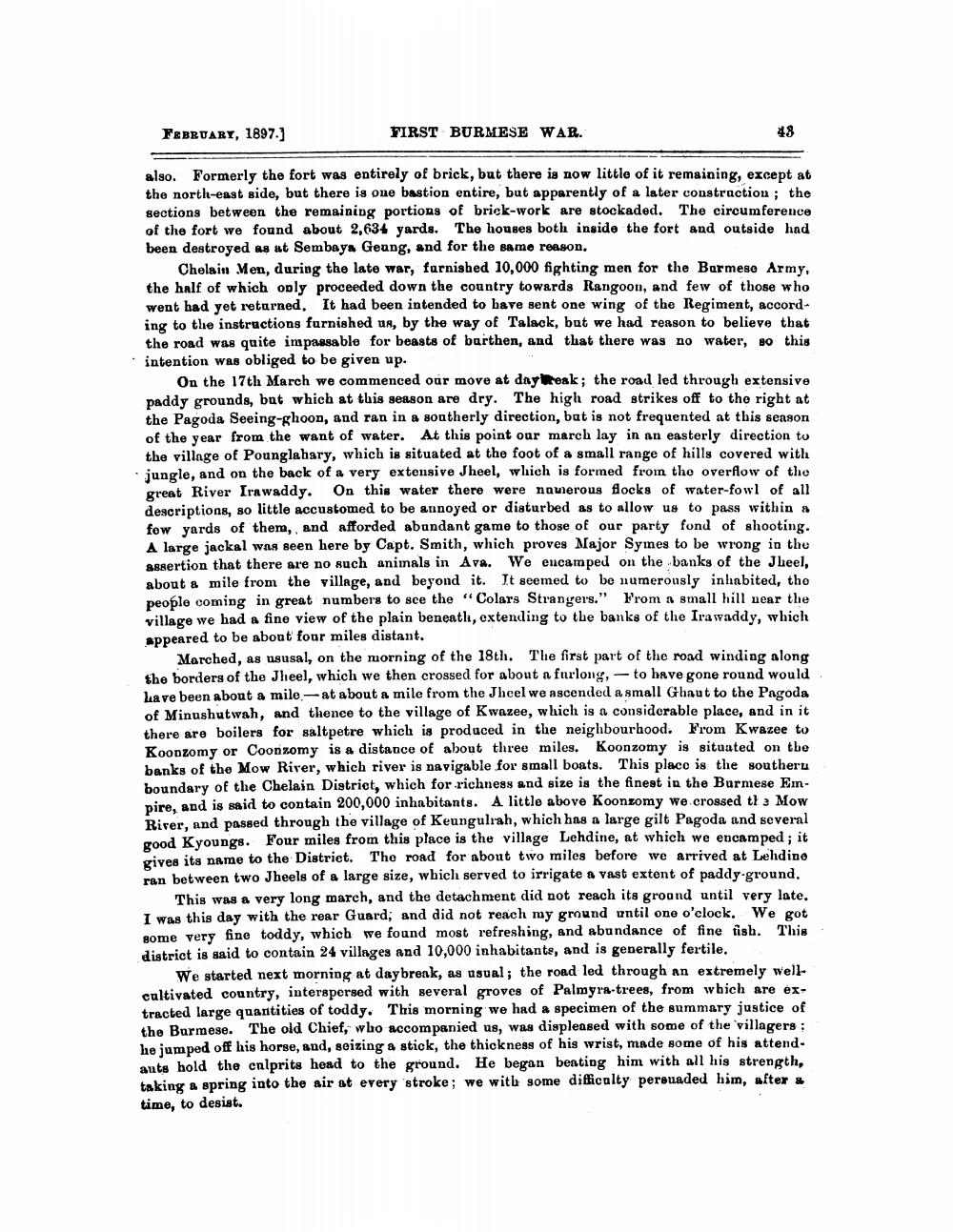________________
FEBRUARY, 1897.]
FIRST BURMESE WAR.
48
also. Formerly the fort was entirely of brick, but there is now little of it remaining, except at the north-east side, but there is one bastion entire, but apparently of a later construction; the sections between the remaining portions of brick-work are stockaded. The circumference of the fort we found about 2,634 yards. The houses both inside the fort and outside had been destroyed as at Sembays Geung, and for the same reason.
Chelain Men, during the late war, furnished 10,000 fighting men for the Barmeso Army, the half of which only proceeded down the country towards Rangoon, and few of those who went had yet returned. It had been intended to have sent one wing of the Regiment, according to the instructions furnished up, by the way of Talack, but we had reason to believe that the road was quite impassable for beasts of burthen, and that there was no water, so this intention was obliged to be given up.
On the 17th March we commenced our move at day reak; the road led through extensive paddy grounds, but which at this season are dry. The high road strikes off to the right at the Pagoda Seeing-ghoon, and ran in a southerly direction, but is not frequented at this season of the year from the want of water. At this point our march lay in an easterly direction to the village of Pounglahary, which is situated at the foot of a small range of hills covered with jungle, and on the back of a very extensive Jheel, which is formed from the overflow of the great River Irawaddy. On this water there were namerous flocks of water-fowl of all descriptions, so little accustomed to be annoyed or disturbed as to allow us to pass within a fow yards of them, and afforded abundant game to those of our party fond of shooting. A large jackal was seen here by Capt. Smith, which proves Major Symes to be wrong in the assertion that there are no such animals in Ava. We encamped on the banks of the Jheel, about & mile from the village, and beyond it. It seemed to be numerously inhabited, tho people coming in great numbers to see the "Colars Strangers." From a small hill near the village we had a fine view of the plain beneath, extending to the banks of the Irawaddy, which appeared to be about four miles distant.
Marched, as ususal, on the morning of the 18th. The first part of the road winding along the borders of the Jheel, which we then crossed for about a furlong, - to have gone round would have been about a mile--at about a mile from the Jheel we ascended a small Ghaut to the Pagoda of Minushutwah, and thence to the village of Kwazee, which is a considerable place, and in it there are boilers for saltpetre which is produced in the neighbourhood. From Kwazee to Koopzomy or Coonzomy is a distance of about three miles. Koonzomy is situated on the banks of the Mow River, which river is navigable for small boats. This place is the southeru boundary of the Chelain District, which for richness and size is the finest in the Burmese Empire, and is said to contain 200,000 inhabitants. A little above Koonzomy we crossed th 3 Mow River, and passed through the village of Keunguliah, which has a large gilt Pagoda and several good Kyoungs. Four miles from this place is the village Lehdine, at which we encamped; it gives its name to the District. The road for about two miles before we arrived at Lehdino ran between two Jheels of a large size, which served to irrigate a vast extent of paddy-ground.
This was a very long march, and the detachment did not reach its ground until very late. I was this day with the rear Guard; and did not reach my gmund until one o'clock. We got gome very fine toddy, which we found most refreshing, and abundance of fine fish. This district is said to contain 24 villages and 10,000 inhabitante, and is generally fertile.
We started next morning at day brenk, as usual; the road led through an extremely wellcultivated country, interspersed with several groves of Palmyra-trees, from which are extracted large quantities of toddy. This morning we had a specimen of the summary justice of the Burmese. The old Chief, who accompanied us, was displeased with some of the villagers : he jumped off his horse, and, seizing a stick, the thickness of his wrist, made some of his attend. auts hold the culprits head to the ground. He began benting him with all his strength, taking a spring into the air at every stroke; we with some difficulty persuaded him, after time, to desiat.




